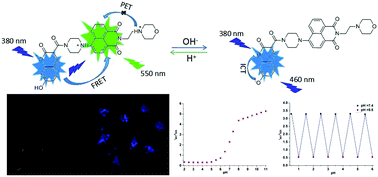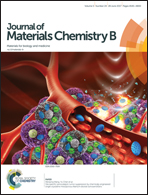A reversible ratiometric two-photon lysosome-targeted probe for real-time monitoring of pH changes in living cells†
Abstract
Lysosome pH is known to be acidic (4.5–5.5) and has emerged as a critical physiological factor for lysosome activities and functions. Herein, we designed a novel ratiometric lysosome-targeted fluorescence resonance energy transfer (FRET) pH probe, which was fabricated by integrating the coumarin moiety (donor) with the naphthalimide moiety (acceptor). The sensing mechanism was essentially an integration of ICT and FRET processes, leading to the simultaneous intensity enhancement of coumarin and naphthalimide with a pH increase. Furthermore, morpholine was introduced as a lysosome-targeted group. Moreover, the probe could respond to pH in a proportional relationship at very broad range from pH 4.5 to 11.0 and showed remarkable advantages, including rapid response, high sensitivity and selectivity, suitable pKa of 5.62, and good reversibility. Furthermore, the probe was successfully used as a ratiometric TP lysosome-targeted fluorescence probe, not only for imaging of lysosomal pH, but also for visualizing chloroquine-induced changes of intracellular pH in real time in living cells with low cytotoxicity and autofluorescence. These proof-of concept studies demonstrate the practical application of the probe in biological systems.



 Please wait while we load your content...
Please wait while we load your content...